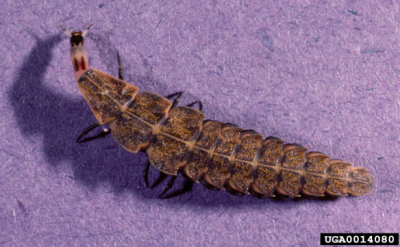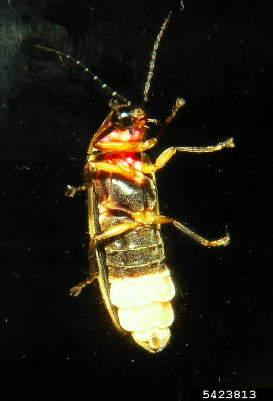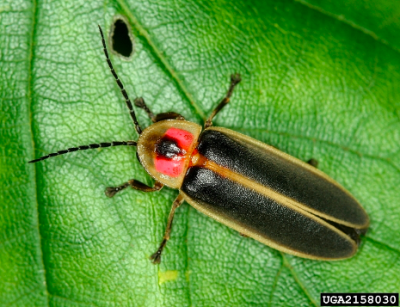
Fireflies – those tiny sparkling lights that appear on summer evenings- aren’t really flies and don’t use fire to make light! They are also called lightning bugs and glowworms, depending on where you find them. These little insects are a type of soft-winged beetle just like ladybugs.
There are many different types of fireflies. They can be as small as one-quarter inch or more than one inch long. They have a typical insect life cycle. The adults only live for about 3 weeks. After finding a mate, adult females lay eggs. The eggs develop into larvae that may live underground for as long as two years, feeding on snails, earth worms and other insects. When fully developed, the larvae move to the pupae stage for several weeks until they emerge as adults to continue the cycle. While some adult fireflies emit light, all larvae glow through a process called bioluminescence.
Life Cycle

Firefly Larva

Some species of firefly larvae can be aquatic—they even have gills—while others live almost entirely in trees or fields.
About that Light
Bioluminescence is produced in special organs in the firefly’s lower abdomen using two chemicals, luciferin and luciferase. Luciferin produces the light, which is called a “cool” light because it does not produce heat. Luciferase is an enzyme that triggers the light emission.

This light is used to attract a mate, to communicate, to warn away predators and to identify territory. Not all fireflies will “glow” but usually both males and females will use the light for identification and location.
Fireflies thrive in forests, fields and marshes near lakes, rivers, ponds, streams and vernal pools. They prefer warm humid areas where water lasts longer than the surrounding areas, such as ponds, streams and rivers. They need a moist environment to survive.
Fireflies are found in all parts of the world, except Antarctica. Not all kinds of fireflies are found everywhere. Some are only found in Asia, some only in the southern US. In New England, the most common type is the Photinus variety.
Types of Fireflies

While there are about 150 species of fireflies in North America, there are about six that are common in the eastern US. They are the Photinus, which means “shining,” the Photuris, for “luminous tail,” and Pyractomena – for “fire.” The Photinus carolinus, a species that produces synchronized lighting displays, is found mostly in southern parts of the US.
The most common species in Connecticut is Photinus pyralis, aka, the common eastern firefly or the big dipper firefly, so named because of the males’ swooping J-curve flight. Fireflies usually appear from May, when just a few can appear, through June and July, when more adults emerge. Males usually display more brightly than females but some don’t produce light at all. Flashes start to appear at dusk and might continue for several hours in full darkness. While it is common to see flashes in open fields, some species occupy the treetops, others stay on the ground, producing a greenish, pale blue or yellow light.
Why do these beetles flash?
Firefly males and females use their lights mostly to find a mate. Sometimes it is only the male that will light up. Usually though both sexes glow to attract a mate. Fireflies will also use their light to communicate, to defend a territory or to warn predators.
The Fireflies are Missing
In recent years there have been fewer sightings of fireflies in some areas of the US. Reasons for this decline are unclear but a few seem to be certain. One is the decrease in areas where fireflies can live due to development of their habitat. Another reason is increased light pollution from those same areas of development. This type of pollution happens when light from business areas, shopping centers and housing developments add street lights that make it difficult for fireflies to signal to each other when mating. This reduces the number of eggs that would lead to more fireflies the next season. Other reasons for a decline in the firefly numbers could be increased use of pesticides and more human use of water bodies where fireflies live.
How to Help Fireflies
Here are several ways to benefit firefly populations:
- Turn off outside lights at night
- Plant some trees and leave litter under trees for fireflies to grow
- Add an area of calm water to your property, such as a water garden
- Avoid use of pesticides, especially on lawns
For more information about fireflies and ways to help increase their populations, investigate the Firefly Research and Conservation organization at firefly.org.